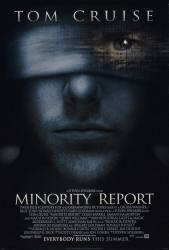Visible crew/equipment: When John Anderton is walking around the hotel room before meeting Leo Crow, just before he spots the photos on the bed, he glances over towards the direction of the bed - if you look to the left of him, you can make out a cameraman's face and hand where he is holding a camera in the reflection of the glass window.
Continuity mistake: The wooden balls etched with the Perpetrator and Victims show the grain running left-to-right across the names when they are first displayed on the cutting machine. But when Anderton removes the balls and places them on the screen (or drops), the names appear to be written with a pen, and the grain is either non-existent or run top-down across the names. This suggests the balls on display in the cutting machine are nicely generated by a computer and much different to the actual props.
Continuity mistake: When the Precrime team are examining the Precogs in the pool, Fletcher folds his arms. In the next shot he folds his arms again.
Continuity mistake: When Lara, standing, is putting on Lamar's tie while he is seated, he gives himself away regarding the drowning of Anne Lively. Lara's arms stop moving and we see her standing straight, her arms by her side, and she says that she never said that Anne was drowned. We cut back to Lamar, and Lara still has her arms around Lamar.
Continuity mistake: When we see the Leo Crow previsions for the first time, we see the numbers "9" and "6" backwards because we are seeing the previsions from behind the screen. But in the cyberparlor we see the previsions from the same side that Anderton and Riley are watching them, and the numbers are still backward.






Answer: No, he didn't change the fact that it was going to happen. He prevented it from happening. But until he stopped it, it was going to happen. And no matter how many times you look back at that sequence, it was going to happen. Up until a point, it was going to happen. It was just prevented.
Garlonuss ★